
5 Tips To Organize Your Art Studio For Maximum Creativity
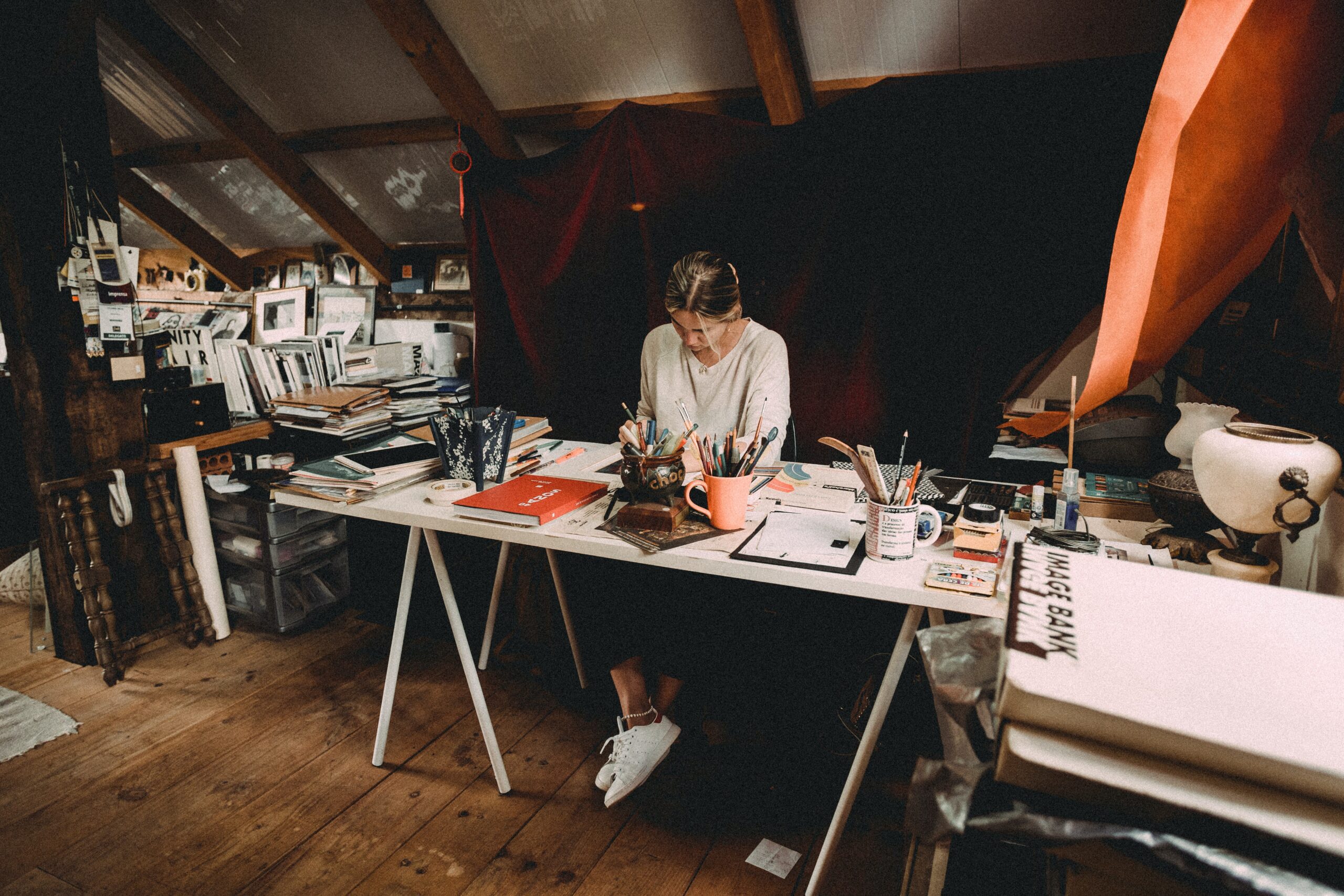

*This post contains affiliate links. Arts to Hearts project receive small commissions for purchases made through these links at no extra cost to you. These commissions help us keep this site up and running, in order for us to keep providing helpful and inspiring art content*
Do you find it challenging to maintain a clean and orderly workspace when creating art? Have you ever pondered the secret to the orderliness of many artists’ studios? Have you ever been so discouraged by the disarray of your surroundings that it prevented you from getting anything done?
Although making a mess is often an integral part of the creative process, we shouldn’t accept this as an excuse to let our studios get out of control.
Therefore we should always try to keep our studio as clean and organized as possible because an artist’s studio needs to be conducive to their work. That’s why it’s crucial to set up the space to support your efficiency. Many fantastic tools can help you get organized, but there are also some low-cost solutions to make your studio look and function the way you’ve always imagined it should.
But before cleaning your studio, it’s essential to evaluate your artistic routine in your studio setting. Before starting your cleaning mission, ask yourself these questions: How can I improve my workflow? Which part of my studio do I spend most of my time in? Is there something I should change about this space? Depending on the materials you use and the layout of your studio, this could mean a variety of things. But whether you’re an artist or a designer, you can always do something to better your studio.
so scroll down to learn five helpful tips that will help you in organizing your art studio for maximum creativity and happy studio space.
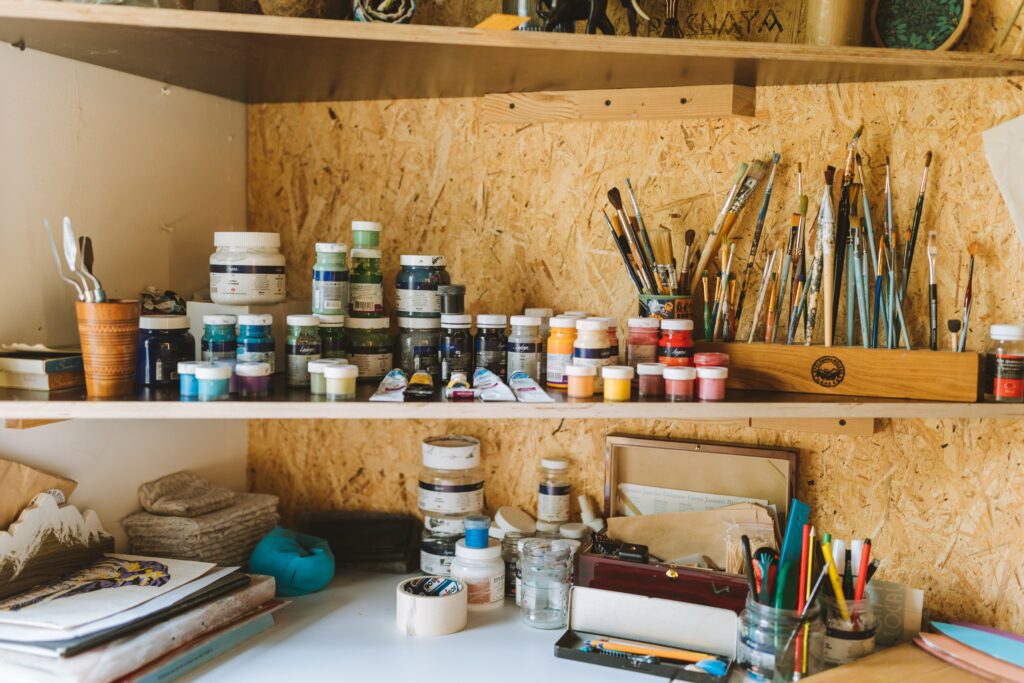
But before that question arises that why we should clean our studio?
If someone asks you to imagine an artist’s studio, your mind will immediately think of space with too many paints, brushes, canvases, and many other art supplies placed all over the floor and ceilings. And we tend to believe that an artist’s space is supposed to be messy.
But that should not be an ideal case. I know you must be thinking that a lot of artists can only work when there is a mess around them, and in the same way, a lot of artists can also work only when their space is all tied up.
I get the point, but I believe every artist should clean their space for three main reasons.
You’ll save money! When you finally have a complete inventory of what you have, you won’t repeat the error of purchasing multiple tubes of the same paint color just because you can’t find the one you need when you need it.
You’ll save time! You will be aware of everything you possess and the location where you are storing it, allowing you to access it at any time you require it. You won’t have to endure the aggravation of wasting time seeking that difficult-to-find hue you need.
You’ll be more productive! A tidy and well-organized studio inspires creative thinking and makes it easier for you to concentrate on your paintings. You’ll be able to get more done in a shorter amount of time.
Material & Equipments
Now that we have enlightened you on the reasons why you should clean your studio, it is time for us to inform you about all of the supplies and equipment that are necessary for every artist’s studio.
Before you can even begin the task of cleaning your studio, you need to be familiar with the fundamental necessities that are required of every artist’s workspace. So keep reading if you want to find out more about that.
Work Table With Drawer
The majority of your creative work, such as sketching and journaling, will take place in this section. A place to work absolutely needs a table! It is recommended that you keep a set of pens, erasers, pencils, and paper pads within easy reach when using this. In addition to that, you can take care of business-related tasks and create digital work on your laptop or desktop computer while you are here.
Rolling Carts
All of the painting supplies, such as watercolor pans, oil paints, solvents, paint brushes, atomizers, and so on, should be stored in this area. Choose one that has rollers so that you can move it around the studio with ease, especially when you are working on huge paintings. This is extremely important.

Cabinet
It is recommended that you keep your canvases in this area so that they do not become dirty. You might also keep items in here that you have not yet opened but need to store, such as paint sets, brushes, unopened oils, and solvents. For example, you could keep paint sets in here.
Hidden storage
Put goods in this box that you don’t make frequent use of, such as clothes or books. For instance, old canvases, canvas protectors, gun tackers, nails, cement, clay, and any other material you can think of. Because certain art supplies also give off an offensive stench, it is best to keep them concealed. It is also possible to store here essential cleaning supplies such as soap and sprays for disinfecting surfaces.
Bookshelf
Having a bookshelf at your workspace puts all of your books, zines, pamphlets, and other reading materials within easy reach, which is helpful in the event that you need to conduct some research prior to beginning work or while you are already on the job.
Lamp
An artist’s best buddy is a lamp, whether it be a standing lamp or a desk lamp. You will need a robust lamp if you want to work at night or if you need to do some detailing that requires concentrated light in order to complete the task successfully.
Lighting
Lighting is one of the components that is considered to be the most crucial when organizing an artist’s studio. Is there access to natural light in the area you’re working in? If yes, how little or how much are you going to get? Consider how the light is affecting the space by going inside the suggested room at different times of the day and analyzing the results. The lighting is quite important since, without it, there may be difficulties in appropriately judging and blending colors.
Comfort
The production of art will be hampered, regardless of how well-designed and organized your artist studio may be, if it is an uncomfortable space. Do you have access to things like chairs, tables, easels, etc. that could make your job easier? Are you able to move around without difficulty? Since you will be spending a significant amount of time in this location, you should make sure that it is conducive to your comfort.
Now comes how to organize your art studio, so keep on reading to learn about it all.
Categorize Your Materials & Tools
The first step in organizing your art studio is to arrange your supplies into different storage boxes. Maintaining order in your studio is as simple as assigning a permanent home to your creative collections, whether paintbrushes, mail or finished works of art.
Look for used shelves at a secondhand shop or yard sale if you’re strapped for cash. Clear plastic containers or jars can help keep materials organized and easy to find.
Because having ready access to the tools you use most frequently is essential while making art. One way of arranging your tools in an organized manner is using a peg board. So, buy a peg board to hang your studio equipment on. There are some substantial upsides to using a pegboard for storage. Your tools will be well-organized and simple to find and return; you’ll save floor space by storing them vertically; the solution will cost you very little; and, as a bonus, your newfound organization will look great and reflect your unique style.
You can also arrange your supplies in different boxes and drawers. But once you put everything in its designated places, make it a habit to return things like aprons, paint, brushes, and sponges to their storage areas as soon as they are no longer in use.
Because keeping on top of things is possible when you put everything back in its place after every use. This way, you will be more organized, and a more organized workspace means less time spent hunting for supplies and more time spent making art.
Keep Only Materials That Spark Joy & Let Go Of The Rest
The next step in organizing your art space should be getting rid of all the materials you don’t need or won’t ever use because sometimes the allotted area for something is in the garbage or recycling. If you have hoarding tendencies, you probably already know it, and if you do, you’ll have to make an extra effort to accept that you don’t need all those extra paint brushes or finished paint tubes.
But don’t go tossing out perfectly good art supplies just because they’re not being used. Give them away! Many institutions greatly appreciate donating arts and crafts materials, including schools and daycares, YMCAs, community centers, shelters for battered women, churches, art centers, and more.
So find a place near you that loves having all these art supplies. Donating locally is recommended. You can also find a place to donate art supplies by doing a Google search for “where to donate art supplies [your city/town/county name].”
But before you donate, check to see if the items you plan to donate can be put to good use? because No one needs old paint or bristle brushes.
Therefore, when cleaning out your art supplies, you should make at least two distinct piles: one for trash and one for donations.
This won’t be an easy task, So give this task some good time and detox your studio from all the unwanted things and supplies.
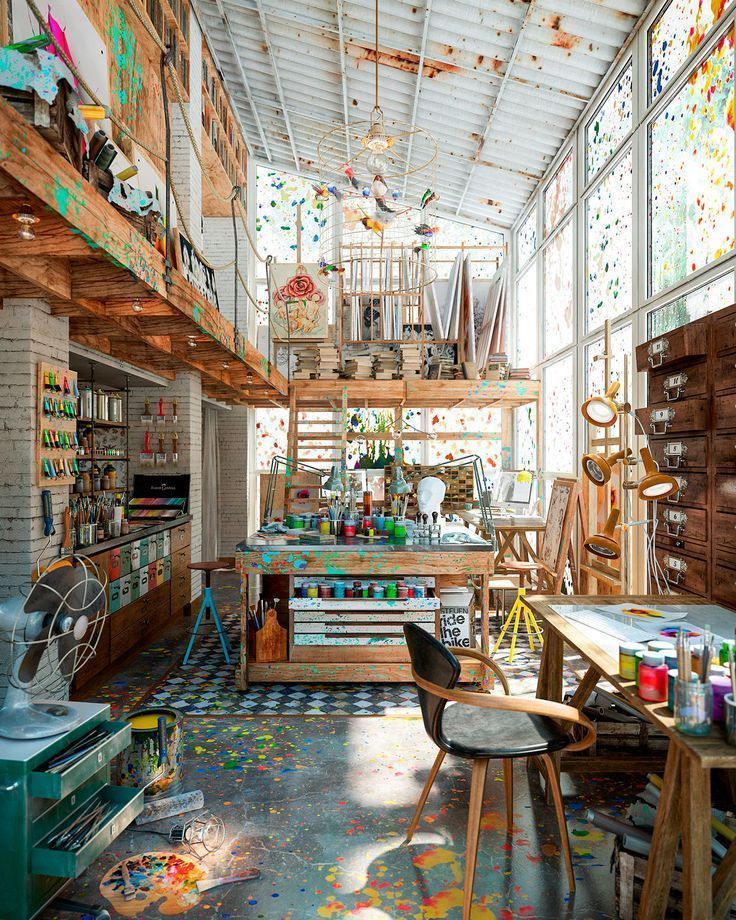
Label Everything
Labeling your materials is another excellent method for speeding up your processes. Putting names on things in storage makes it easier to find items in a vast collection. Plus, when it’s time for cleanup, you may save the effort of searching for a suitable container.
You can save time and effort with a label maker, but if you want to give your belongings a more personalized feel, you can write labels on random bits of paper and glue them onto containers instead.
If you want to Organize your supplies by color? Then, to make it easier to discover the precise shade you need, you can use colored label stickers.

Make Use Of The Vertical Space
I am aware that many of us are competing for limited space. It’s possible that the only space available to you for creative endeavors is a small nook rather than a whole room. If this is the case, vertical storage will unquestionably become your new greatest ally. Make the most of the vertical space you have!
Mount racks, shelves, or cubbies on the wall so that they reach all the way up to the top of the room. However, you should ensure that you have a stable step stool so that you can reach things that are higher up.
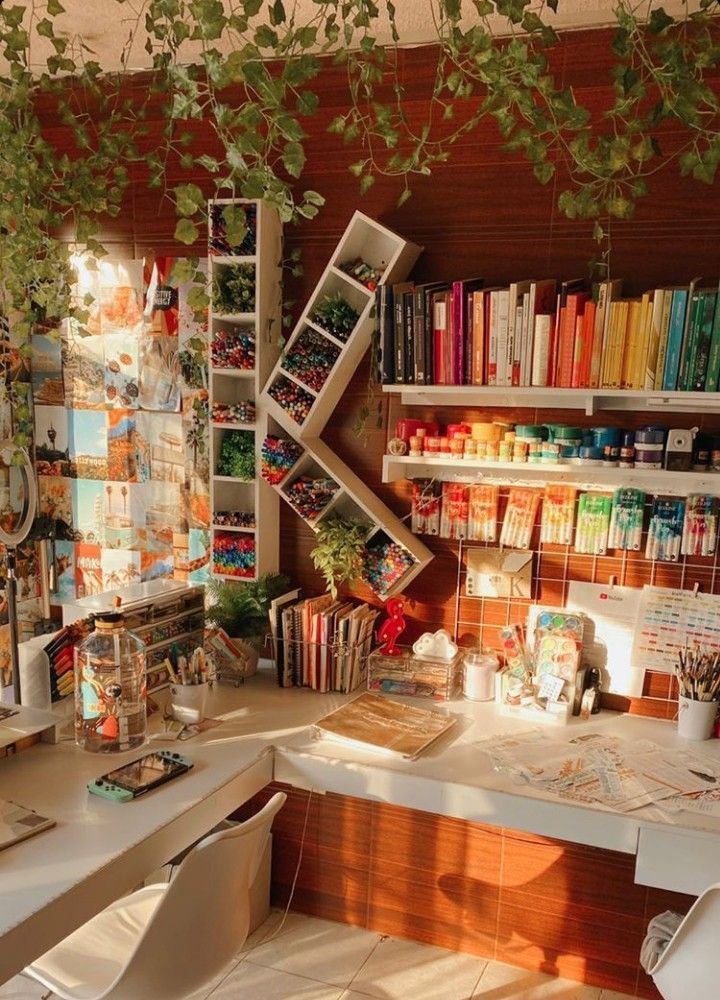
Don’t let The Cleanliness Of Your Studio Slip Once It’s Been Restored
The last step in organizing your studio is to make a constant effort to keep your studio clean. Once you’ve established it, a little effort is required to keep your art supply and project storage system in good working order.
Spend a minute or two putting things back where they belong at the end of the day or when you’re done with a project. Put away your paintbrushes and pencils and clean off your desk.
Your future self will thank you for taking the time now to do this. Because the next time you sit down to work on a project, you’ll have plenty of room to spread out and quickly access everything you need.
Plus, since your studio would be less of a hassle, you will probably produce more finished products.
So these are some tips from our side to help you organize your studio. Now it’s your turn to tell us how you manage it. You can also share pictures of your studio with us, and we can share them with our community for some inspiration (with your name, of course).
So pour in your suggestions and advice, and I will see you with the next article. Until then, have a good week ahead, and keep creating the magic you do.

Sign Up Now for Arts To Hearts Project’s Newsletter
and receive all art-related stuff right in your inbox every week.









































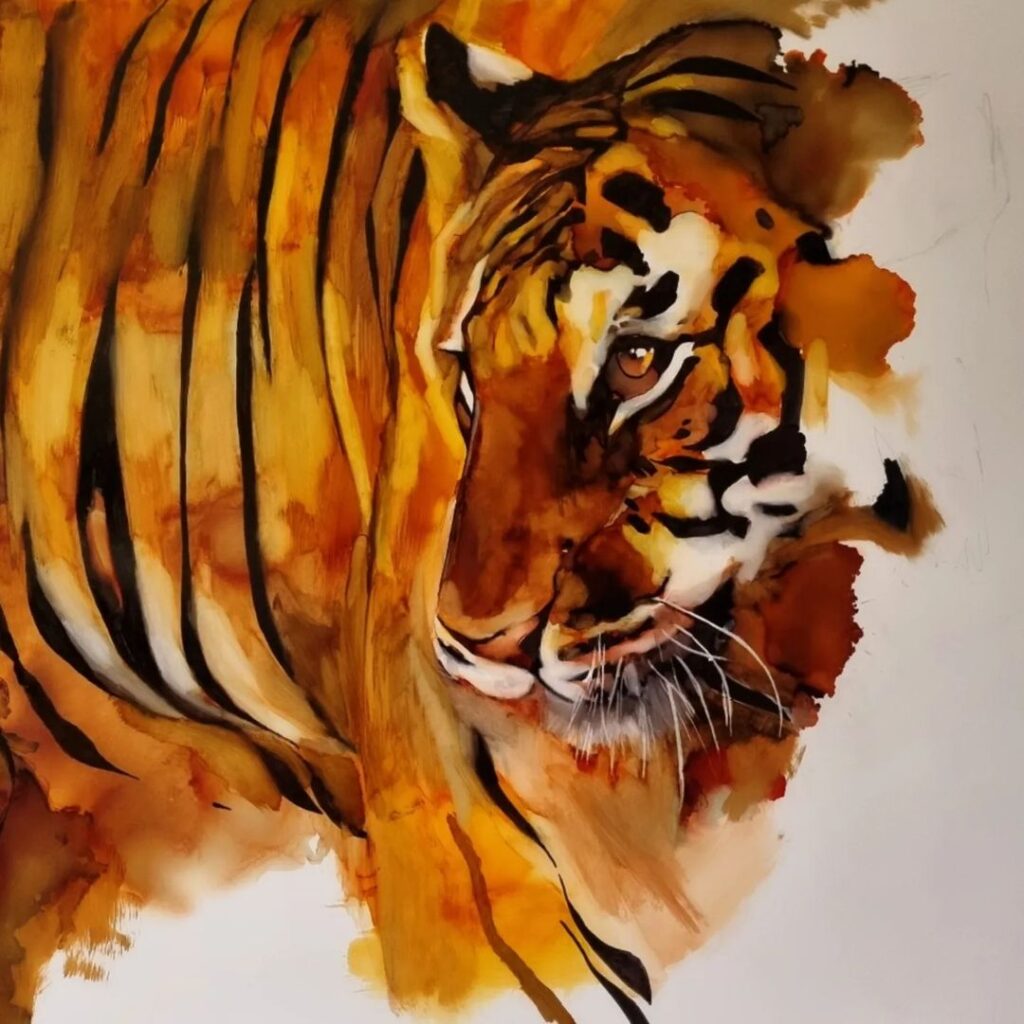


Comments 13